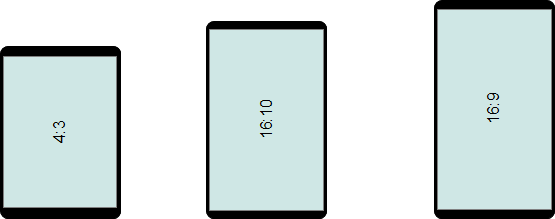32
Fixed Layout Aspect Ratio
A disussion on understanding the effect of viewport aspect ratio when designing fixed layout ePubs for different devices. Updated: 2012-10-31
Overview
A core consideration that is not often discussed or addressed is the concept of the aspect ratio of a monitor or viewport. This is probably because iBooks is currently the only commercial system currently available on devices and 4:3 currently rules everyones thinking.
AZARDI in particular is targeted at all platforms and devices irrespective of the viewport, window or monitor size. Current fixed layout strategies target specific devices. The IDPF specification takes into account all possible viewports; desktop and Online reading systems must as well. What happens when users change their viewport size and shape?
The most common device aspect ratios are 4:3 (iPad), 16:10 (Kindle Fire) and 16:9 (most Android devices).
The Aspect Ratios
Here are the three dominant aspect ratios presented in portrait and landscape modes. The IDPF Spec allows you to change fixed or flow content and orientation interchangeably in a document. That can be very powerful when creating high presentation content such as education, technical, reference and other content "not novels".


Fitting them together
How do these different aspect ratios come together at book presentation time in a reader. Basically they don't.
The specification states that reading devices should fit the various specified viewports to the screen as best they can. That is illustrated here.
This highlights a fact about fixed layout. It's fixed! That means the content is defined as a certain number of pixels in width and height, and readers should squeeze that onto their screens as best they can.

Fixed Layout Spreads
Finally here are the page spreads within the various device aspect ratios without letterbox or pillbox decoration.
The 4:3 screen gives two pages which are pretty much the same as a 6in x 9in book page. The spread page shapes for 16:10 and 16:9 create interesting design opportunities freed from the relentless verticalness of print pages.

Summary
As the world of reading devices or environments grows aspect ratio is going to be an important design and production consideration.
In addition the ability to switch between fixed pages and reflowable pages adds enormous power to many types of content. This depends on reading devices handling the flow content as well as the fixed layout content and maintaining visual context.
The end result of navigating from a flow page to a fixed layout landscape or portrait page should not be unlike a content isolating pop-up in Apples iPublisher, or similar hand-crafted strategies.
Remember that iBooks flow ePub3 also supports non-linear content pop-up window overlays as has AZARDI since version 7. If a section is non-linear in the spine and a link provided the popup page can be used to enhance your content. The non-linear page is outside the flow of the book and must have its own styling provided.
Our focus while creating AZARDI fixed/flow layout is locked in to getting fixed/flow correct. When you see fixed portrait and fixed landscape in action, and especially in action with re-flowable content the spread feature is a lot less appealing.
